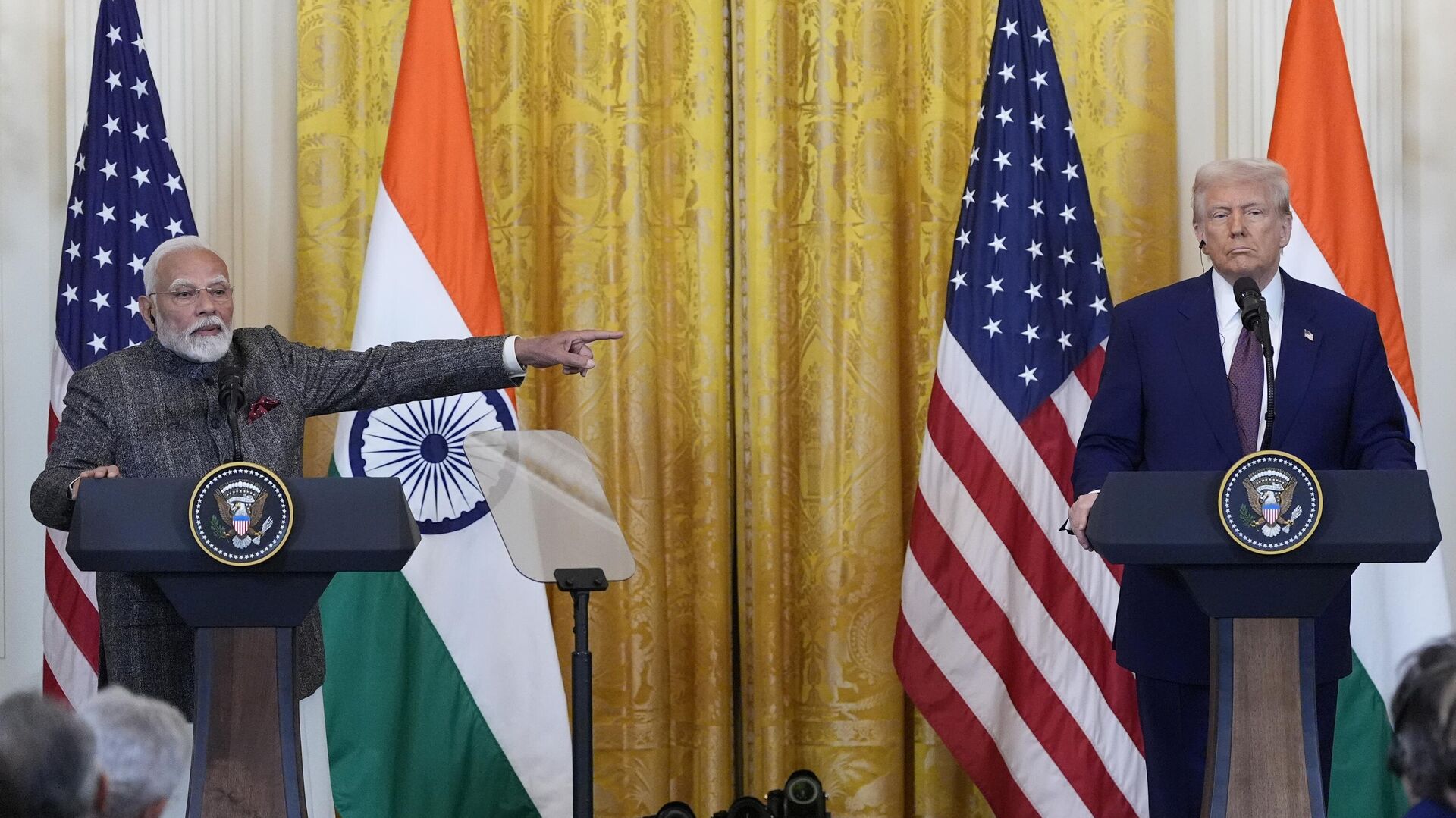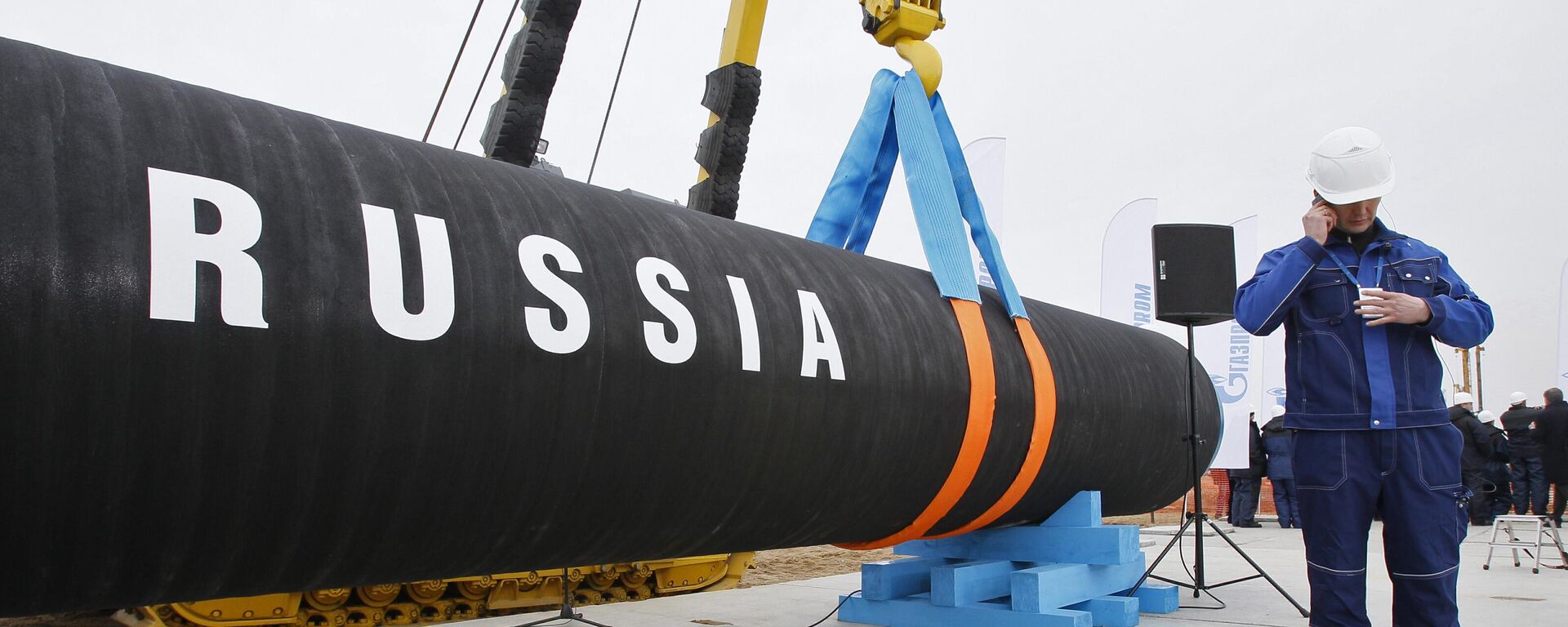https://sputniknews.in/20250214/how-is-india-navigating-trumps-reciprocal-tariff-challenge-8772457.html
How is India Navigating Trump's Reciprocal Tariff Challenge?
How is India Navigating Trump's Reciprocal Tariff Challenge?
Sputnik India
US President Donald Trump called out India for charging "tremendous tariffs". At a joint presser with PM Modi, Trump described the tariffs imposed on US imports by India as a big problem.
2025-02-14T19:45+0530
2025-02-14T19:45+0530
2025-02-14T21:45+0530
business & economy
donald trump
nirmala sitharaman
narendra modi
new delhi
us
india
trade
barter trade
trade barriers
https://cdn1.img.sputniknews.in/img/07e9/02/0e/8774418_0:0:3068:1725_1920x0_80_0_0_3dd95f0bac83984d2e2a1c7afab1818f.jpg
US President Donald Trump's order, which proposes the potential imposition of "reciprocal tariffs" on all countries with which the United States has a trade deficit, has raised concerns in India. The US is India's largest export market and its biggest trading partner. The presidential memorandum instructs American agencies to evaluate the implications of retaliatory tariffs and to report their findings to the President within 180 days.At the joint press conference with PM Modi, Trump bemoaned the fact that India charged "30 to 40 to 60 and even 70% tariffs on so many goods, and in some cases far more than that".The US President also urged India to increase its crude and Liquefied Natural Gas (LNG) imports from the US in a bid to offset the trade deficit, which stood at around $41 billion in January-November 2024 period.Both Trump and Modi have announced that they would try and seal the "first tranche" of a trade deal by autumn 2025, targeting a $500 billion bilateral trade turnover by 2030. Current trade levels hover around $190 billion for the January-November 2024 period, according to official data, with India's biggest exports to the US being engineering goods, electronics, gems and jewelry, and pharmaceuticals.India will wait to watch how the trade deal negotiations unfold in coming weeks and months, Foreign Secretary Vikram Misri commented during a briefing after the Modi-Trump talks, addressing the threat of reciprocal tariffs.Speaking at the India Energy Week (IEW) in New Delhi this week, Petroleum and Natural Gas Minister Hardeep Singh Puri indicated that more energy supplies on the global market would definitely have a "sobering impact" on global prices to the benefit of India, the world's second-biggest oil importer.However, Puri said that there were several "challenges" involved and that Indian importers would go for the cost-effective option available on the market.Meanwhile, Trump's tariff threat could pose "limited challenges" for India in sectors such as pharmaceuticals, where the country was ranked as a "global leader", Dr Ajai Sahai, the Director-General and CEO of Federation of Indian Export Organisations (FIEO), told Sputnik India. Yet, the US policy also presented India with the opportunity to diversify its exports, Sahai said.US President's tariff threats should be viewed as a "negotiating leverage" to get the best deal for America, former Indian Ambassador Ashok Sajjanhar told Sputnik India.He reminded that weeks before Modi's visit to the US, Finance Minister Nirmala Sitharaman announced that India would reduce duties on high-end motorcycles, cars, and smartphone parts, a move likely to be "viewed positively by the Trump administration."These duty cuts, along with India's pledge to increase energy imports from the US, were positive steps in resolving trade differences, Sajjanhar noted.Meanwhile, the introduction of customs duty rationalisation was aimed at making the Indian economy more self-reliant (Aatmanirbhar) and was not a response to Trump's tariff announcements, Minister Sitharaman stressed in an interview with NDTV.Echoing Prime Minister Modi, Sajjanjar said that India could convert the threats posed by Trump's Make America Great Again (MAGA) policy to its advantage."I believe we have to leverage these policies to have optimum results in a variety of sectors. All in all, I expect bilateral trade exchanges to increase in coming years," Sajjanhar concluded.
https://sputniknews.in/20250210/india-open-to-long-term-energy-deals-with-russia-petroleum-minister-8754775.html
new delhi
us
india
russia
Sputnik India
feedback.hindi@sputniknews.com
+74956456601
MIA „Rossiya Segodnya“
2025
Dhairya Maheshwari
https://cdn1.img.sputniknews.in/img/07e6/0c/13/138962_0:0:641:640_100x100_80_0_0_2cb44360dbcdf6d84bf4b299cd045917.jpg
Dhairya Maheshwari
https://cdn1.img.sputniknews.in/img/07e6/0c/13/138962_0:0:641:640_100x100_80_0_0_2cb44360dbcdf6d84bf4b299cd045917.jpg
News
en_IN
Sputnik India
feedback.hindi@sputniknews.com
+74956456601
MIA „Rossiya Segodnya“
Sputnik India
feedback.hindi@sputniknews.com
+74956456601
MIA „Rossiya Segodnya“
Dhairya Maheshwari
https://cdn1.img.sputniknews.in/img/07e6/0c/13/138962_0:0:641:640_100x100_80_0_0_2cb44360dbcdf6d84bf4b299cd045917.jpg
trump news, trump modi meeting, trump news, trump tariffs, trump reciprocal tariffs, us lng exports, us oil exports to india, russian oil exports, russia india trade, russian oil exports to india, trump maga, modi trump summit, modi us visit
trump news, trump modi meeting, trump news, trump tariffs, trump reciprocal tariffs, us lng exports, us oil exports to india, russian oil exports, russia india trade, russian oil exports to india, trump maga, modi trump summit, modi us visit
How is India Navigating Trump's Reciprocal Tariff Challenge?
19:45 14.02.2025 (Updated: 21:45 14.02.2025) While signing the Executive Order on "reciprocal tariffs," Donald Trump slammed India for slapping "tremendous tariffs" on US imports. He called this a "big problem" at a joint press conference with PM Modi.
US President Donald Trump's order, which proposes the potential imposition of "reciprocal tariffs" on all countries with which the United States has a trade deficit, has raised concerns in India. The US is India's largest export market and its biggest trading partner. The presidential memorandum instructs American agencies to evaluate the implications of retaliatory tariffs and to report their findings to the President within 180 days.
Trump has justified his threat of imposing reciprocal tariffs as means to level the playing field. A White House Fact Sheet on Thursday stated that US levied a 5% duty on Indian agricultural imports, while India charged US agri-exporters a 30% duty. Further, it noted that India charged a 100% tariff on American motorcycles, while the US charged a 2.4% tariff on Indian motorcycles.
At the joint press conference with PM Modi, Trump bemoaned the fact that India charged "30 to 40 to 60 and even 70% tariffs on so many goods, and in some cases far more than that".
The US President also urged India to increase its crude and Liquefied Natural Gas (LNG) imports from the US in a bid to offset the trade deficit, which stood at around $41 billion in January-November 2024 period.
Both Trump and Modi have announced that they would try and seal the "first tranche" of a trade deal by autumn 2025, targeting a $500 billion bilateral trade turnover by 2030. Current trade levels hover around $190 billion for the January-November 2024 period, according to official data, with India's biggest exports to the US being engineering goods, electronics, gems and jewelry, and pharmaceuticals.
India will wait to watch how the trade deal negotiations unfold in coming weeks and months, Foreign Secretary Vikram Misri commented during a briefing after the Modi-Trump talks, addressing the threat of reciprocal tariffs.
Misri mentioned that last year, India purchased around $15 billion in US energy, with potential for that figure to reach $25 billion soon. He added that the Modi-Trump discussions centered on increasing energy purchases to help reduce the trade deficit between the two countries.
Speaking at the India Energy Week (IEW) in New Delhi this week, Petroleum and Natural Gas Minister Hardeep Singh Puri indicated that more energy supplies on the global market would definitely have a "sobering impact" on global prices to the benefit of India, the world's second-biggest oil importer.
However, Puri said that there were several "challenges" involved and that Indian importers would go for the cost-effective option available on the market.
The minister has rejected the argument that India was looking to cut down its crude imports from Russia, which has been its top crude supplier since 2023.
Meanwhile, Trump's tariff threat
could pose "limited challenges" for India in sectors such as pharmaceuticals, where the country was ranked as a "global leader",
Dr Ajai Sahai, the Director-General and CEO of Federation of Indian Export Organisations (FIEO), told
Sputnik India. Yet, the US policy also presented India with the opportunity to diversify its exports, Sahai said.
US President's tariff threats should be viewed as a "negotiating leverage" to get the best deal for America, former Indian Ambassador Ashok Sajjanhar told Sputnik India.
"Trump followed more or less the same approach with Canada and Mexico, imposing tariffs on both the countries and then ordering a 30-day reprieve. The announcement on reciprocal tariffs is applicable to all the countries and not specifically to India," Sajjanhar pointed out.
He reminded that weeks before Modi's visit to the US, Finance Minister Nirmala Sitharaman announced that India would reduce duties on high-end motorcycles, cars, and smartphone parts, a move likely to be "viewed positively by the Trump administration."
These duty cuts, along with India's pledge to increase energy imports from the US, were positive steps in resolving trade differences, Sajjanhar noted.
"I believe that the US trade negotiators would take cognisance of these developments before making any recommendation to President Trump on the issue of reciprocal tariff," the former Indian Ambassador explained.
Meanwhile, the introduction of customs duty rationalisation was aimed at making the Indian economy more self-reliant (Aatmanirbhar) and was not a response to Trump's tariff announcements, Minister Sitharaman stressed in an interview with NDTV.
"We are looking at our own economy. We are looking to strengthen the foundation of the Indian economy, to make it a manufacturing hub," she was quoted as saying.
Echoing Prime Minister Modi, Sajjanjar said that India could convert the threats posed by Trump's Make America Great Again (MAGA) policy to its advantage.
"I believe we have to leverage these policies to have optimum results in a variety of sectors. All in all, I expect bilateral trade exchanges to increase in coming years," Sajjanhar concluded.



